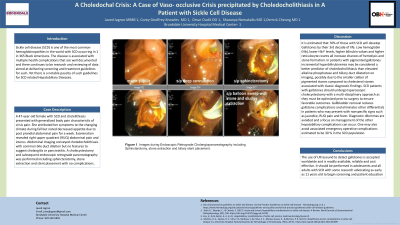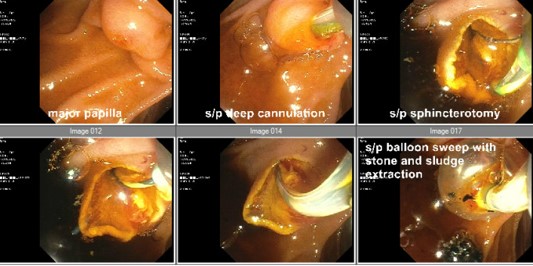Monday Poster Session
Category: Biliary/Pancreas
P1784 - A Choledochal Crisis: A Case of Vaso-Occlusive Crisis Precipitated by Choledocholithiasis in a Patient With Sickle Cell Disease
Monday, October 28, 2024
10:30 AM - 4:00 PM ET
Location: Exhibit Hall E

Has Audio

Javed Jagroo, MBBS
One Brooklyn Health-Brookdale University Hospital Medical Center
Ozone Park, NY
Presenting Author(s)
Javed Jagroo, MBBS1, Corey Geoffrey Knowles, MD2, Omar Oudit, DO2, Sharanya Nemakallu, MD2, Derrick Cheung, MD2
1One Brooklyn Health-Brookdale University Hospital Medical Center, Astoria, NY; 2One Brooklyn Health-Brookdale University Hospital Medical Center, Brooklyn, NY
Introduction: Sickle cell disease (SCD) is one of the most common hemoglobinopathies in the world with SCD occurring in 1 in 365 Black Americans. The disease is associated with multiple health complications that are well documented and there continues to be research and reviewing of data aimed at delivering screening and treatment guidelines for such. Yet there is a notable paucity of such guidelines for SCD related Hepatobiliary Diseases.
Case Description/Methods: A 47-year-old female with SCD and cholelithiasis presented with generalized body pain characteristic of crisis pain. She attributed her symptoms to the changing climate during fall but noted decreased appetite due to post prandial abdominal pain for a week. Examination revealed right upper quadrant (RUQ) abdominal pain and icterus. Abdominal imaging conveyed choledocholithiasis with common bile duct dilation but no features to suggest cholangitis or pancreatitis. A cholecystectomy and subsequent endoscopic retrograde pancreatography was performed including sphincterotomy, stone extraction and stent placement with no complications.
Discussion: It is estimated that 70% of those with SCD will develop Gallstones by their 3rd decade of life. Low hemoglobin (Hb), lower Hb F levels, higher bilirubin values and higher reticulocyte counts all increase chances of hemolysis and stone formation. In patients with pigmented gallstones incremental hyperbilirubinemia may be considered a better predictor of choledocholithiasis than elevated alkaline phosphatase and biliary duct dilatation on imaging, possibly due to the smaller caliber of pigmented stones compared to cholesterol stones associated with classic diagnostic findings. SCD patients with gallstones should undergo laparoscopic cholecystectomy with a multi-disciplinary approach as they must be optimized prior to surgery to ensure favorable outcomes. Gallbladder removal reduces gallstone complications and eliminates other differentials in patients who may present with nonspecific signs such as jaundice, RUQ pain and fever. Diagnostic dilemmas are avoided and a focus on management of the other hepatobiliary complications can occur. One may also avoid associated emergency operative complications estimated to be 30 % in the SCD population. The use of Ultrasound to detect gallstones is accepted worldwide and is readily available, reliable and cost effective. It should be performed in adolescents and all adults with some research advocating as early as 11 years old to begin screening and patient education.

Disclosures:
Javed Jagroo, MBBS1, Corey Geoffrey Knowles, MD2, Omar Oudit, DO2, Sharanya Nemakallu, MD2, Derrick Cheung, MD2. P1784 - A Choledochal Crisis: A Case of Vaso-Occlusive Crisis Precipitated by Choledocholithiasis in a Patient With Sickle Cell Disease, ACG 2024 Annual Scientific Meeting Abstracts. Philadelphia, PA: American College of Gastroenterology.
1One Brooklyn Health-Brookdale University Hospital Medical Center, Astoria, NY; 2One Brooklyn Health-Brookdale University Hospital Medical Center, Brooklyn, NY
Introduction: Sickle cell disease (SCD) is one of the most common hemoglobinopathies in the world with SCD occurring in 1 in 365 Black Americans. The disease is associated with multiple health complications that are well documented and there continues to be research and reviewing of data aimed at delivering screening and treatment guidelines for such. Yet there is a notable paucity of such guidelines for SCD related Hepatobiliary Diseases.
Case Description/Methods: A 47-year-old female with SCD and cholelithiasis presented with generalized body pain characteristic of crisis pain. She attributed her symptoms to the changing climate during fall but noted decreased appetite due to post prandial abdominal pain for a week. Examination revealed right upper quadrant (RUQ) abdominal pain and icterus. Abdominal imaging conveyed choledocholithiasis with common bile duct dilation but no features to suggest cholangitis or pancreatitis. A cholecystectomy and subsequent endoscopic retrograde pancreatography was performed including sphincterotomy, stone extraction and stent placement with no complications.
Discussion: It is estimated that 70% of those with SCD will develop Gallstones by their 3rd decade of life. Low hemoglobin (Hb), lower Hb F levels, higher bilirubin values and higher reticulocyte counts all increase chances of hemolysis and stone formation. In patients with pigmented gallstones incremental hyperbilirubinemia may be considered a better predictor of choledocholithiasis than elevated alkaline phosphatase and biliary duct dilatation on imaging, possibly due to the smaller caliber of pigmented stones compared to cholesterol stones associated with classic diagnostic findings. SCD patients with gallstones should undergo laparoscopic cholecystectomy with a multi-disciplinary approach as they must be optimized prior to surgery to ensure favorable outcomes. Gallbladder removal reduces gallstone complications and eliminates other differentials in patients who may present with nonspecific signs such as jaundice, RUQ pain and fever. Diagnostic dilemmas are avoided and a focus on management of the other hepatobiliary complications can occur. One may also avoid associated emergency operative complications estimated to be 30 % in the SCD population. The use of Ultrasound to detect gallstones is accepted worldwide and is readily available, reliable and cost effective. It should be performed in adolescents and all adults with some research advocating as early as 11 years old to begin screening and patient education.

Figure: Images during Endoscopic Retrograde Cholangiopancreatography including Sphincterotomy, stone extraction and biliary stent placement.
Disclosures:
Javed Jagroo indicated no relevant financial relationships.
Corey Geoffrey Knowles indicated no relevant financial relationships.
Omar Oudit indicated no relevant financial relationships.
Sharanya Nemakallu indicated no relevant financial relationships.
Derrick Cheung indicated no relevant financial relationships.
Javed Jagroo, MBBS1, Corey Geoffrey Knowles, MD2, Omar Oudit, DO2, Sharanya Nemakallu, MD2, Derrick Cheung, MD2. P1784 - A Choledochal Crisis: A Case of Vaso-Occlusive Crisis Precipitated by Choledocholithiasis in a Patient With Sickle Cell Disease, ACG 2024 Annual Scientific Meeting Abstracts. Philadelphia, PA: American College of Gastroenterology.
